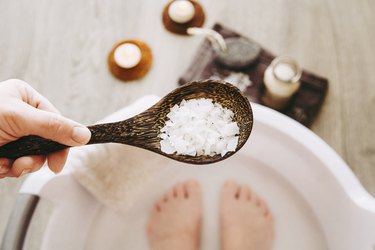
At first, it probably seemed like NBD: itchy feet, a little peeling skin between your toes. But before you know it you have full-blown athlete's foot.
"Athlete's foot, technically called tinea pedis, is a contagious skin infection caused by a fungus," says podiatrist Mark Mendeszoon, DPM, director of the Advanced Foot and Ankle Fellowship with University Hospitals Richmond Medical Center, clinical professor at Ohio University Heritage Medical School, professor at Kent State University School of Podiatric Medicine and spokesperson for the American Podiatric Medical Association.
Video of the Day
Video of the Day
Athlete's foot affects between 15 and 30 percent of the population, according to a September 2015 study in BMJ Clinical Evidence.
You might have gotten it by walking barefoot in a shared shower or on a pool deck, getting a pedicure with tools that weren't properly sanitized or using the same towel or bed as someone who's infected.
Treating athlete's foot can feel like an uphill climb, but these natural remedies are a step in the right direction. Try them and get ready to put your best foot forward!
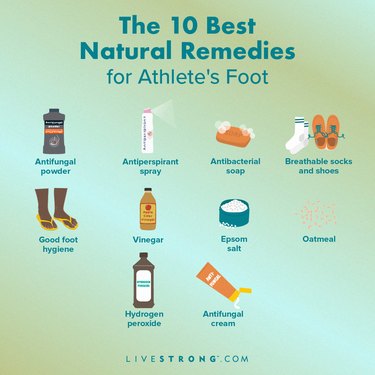
1. Sprinkle on Some Powder
A dry environment is kryptonite to athlete's foot. "Fungi thrive in dark, moist places, so in order to fight it, you have to absorb moisture," Dr. Mendeszoon says.
Powder also reduces friction between the toes and against your shoes, which can aggravate the condition.
How to Use It
Sprinkle powder into your shoes and all over your feet, paying special attention to the skin in between the toes. "That is often where it starts," Dr. Mendeszoon says.
Good to know: It doesn't matter what kind of powder you dust on — baby powder, talcum powder or a medicated variety like Lotrimin Antifungal Powder ($20.32, Amazon). You can even raid your pantry for powdery ingredients like cornstarch or flour.
2. Spray on Antiperspirant
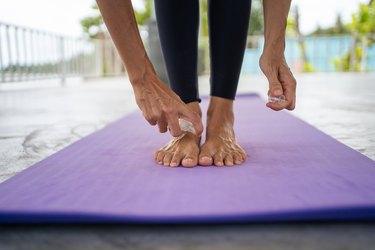
If your feet get sweaty, hear this: The same stuff you spritz under your arms can be used on your tootsies.
"Antiperspirant contains the active ingredient aluminum hydroxide, which blocks your sweat ducts and prevents perspiration," Dr. Mendeszoon says. "Anything you can do to minimize the amount of moisture on your feet will improve athlete's foot condition."
How to Use It
Spray antiperspirant onto the bottom of your feet daily after showering. Be sure to use antiperspirant (which prevents moisture) rather than deodorant (which simply covers up odor).
3. Use Antibacterial Soap and Spray
Kick the organic, botanical soaps to the curb for now. With athlete's foot, you've got to bring out the big guns. We're talking a bar of Dial, people ($5.29 per 8-pack, Amazon).
If left unchecked, athlete's foot can lead to a bacterial infection, Dr. Mendeszoon says. Trust us, you do not want that to happen.
How to Use It
Wash your feet at least once a day with antibacterial soap. "While washing, scrub your feet with a washcloth or brush to open up the sweat ducts and minimize the proliferation of fungus on the skin," Dr. Mendeszoon says.
After cleansing, thoroughly dry between your toes (the ground zero of athlete's foot). Before slipping on your shoes, spray the interior with a disinfectant like Lysol ($10.90 per two-pack, Walmart) — just make sure to let it dry completely before putting the shoes on (you can spray them the night before, for example). "Using Lysol spray daily will minimize the proliferation of fungi, bacteria and viruses," Dr. Mendeszoon says.
4. Wear Breathable Socks and Shoes
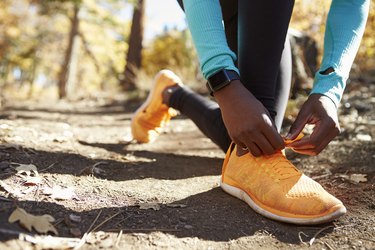
Thick cotton socks and leather or waterproof shoes trap heat and sweat, creating a perfect breeding ground for the spread of fungi. So be strategic when you select your footwear.
How to Use Them
Opt for polymer athletic socks that either wick away wetness or allow it to evaporate, and pair them with kicks that have good airflow (mesh is your friend!). "While we're at it, never wear closed-toed shoes without socks," Dr. Mendeszoon says.
5. Practice Good Foot Hygiene
Athlete's foot fungus is stubborn AF, so you need to be on the attack. This means being diligent about what Dr. Mendeszoon calls good foot hygiene — even once you think the infection has cleared.
How to Do It
Here's how to get on your A-game and stay one step ahead of this gnarly fungus. "When you get home from work, take off your shoes and socks, wash your feet thoroughly and change into a dry pair," Dr. Mendeszoon says. "Before bed, powder your feet and spray your shoes with disinfectant."
6. Try Vinegar
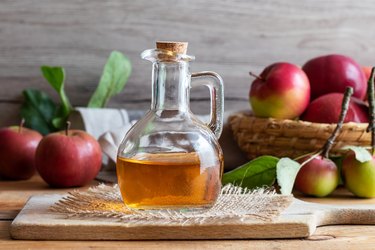
Keep this weapon in your athlete's foot arsenal. "Vinegar is an astringent, so it dries out your feet," Dr. Mendeszoon says. "It also contains acetic acid, which is an antimicrobial agent that can penetrate the skin pores and start attacking the fungus."
A 2017 study in Biomedical and Pharmacology Journal suggests that a fungus responsible for athlete's foot is sensitive to acetic acid.
How to Use It
Try this foot soak recipe from the Cleveland Clinic:
- In a large bowl or plastic tub, combine two parts warm water with one part white or apple cider vinegar. (Red wine or balsamic vinegar will stain your feet). The solution should be deep enough to cover your feet.
- Dip your hooves in for 15 to 20 minutes once a day.
7. Soak in Epsom Salt
It's not just sore muscles that benefit from a briny soak. "Epsom salt creates a hypotonic solution that can draw fluids out of your skin," Dr. Mendeszoon says. "It can diminish inflammation and make your skin drier."
The upshot? Your feet will be less hospitable to fungus.
How to Use It
- Fill a bowl or basin with several inches of warm water.
- Add a half cup of Epsom salt.
- Soak your feet for 20 minutes once a day.
8. Apply Oatmeal
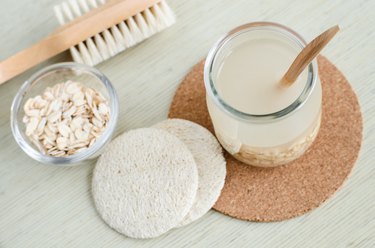
Feet are itching like crazy? An oatmeal soak might be just what the doctor ordered. "It is very important to avoid scratching itchy feet, because the fungus can get into your fingernails and spread more aggressively — not only on the feet, but other body parts too," Dr. Mendeszoon says. "An oatmeal bath can soothe itchiness."
Indeed, a small January 2015 study in Journal of Drugs in Dermatology found that colloidal oatmeal cream significantly improved itch intensity in people assigned female at birth with dry skin.
How to Use It
- Dissolve a half cup of colloidal oatmeal into a basin of warm water. Dr. Mendeszoon recommends Aveeno Soothing Oatmeal Bath Treatment ($6.97, Amazon).
- Soak your feet for 15 to 30 minutes once a day.
- You can also apply a colloidal oatmeal lotion, such as Aveeno Eczema Therapy Daily Moisturizing Cream ($16.49, Amazon).
9. Use Hydrogen Peroxide
"Applying hydrogen peroxide to the feet can be beneficial to reduce fungus," Dr. Mendeszoon says.
Proof in point: A July 2013 study in BMC Research Notes suggests that the antimicrobial properties of hydrogen peroxide inhibit fungal and bacterial growth. The Biomedical and Pharmacology Journal study also found that H2O2 spells doom for fungus.
How to Use It
- Pour 1 cup of hydrogen peroxide into a basin of warm water.
- Pop your feet in for about half an hour each day.
Tip
We know we’ve suggested a bunch of foot soaks, so Dr. Mendeszoon suggests rotating them: Use vinegar one day, Epsom salts the next, followed by oatmeal and finally hydrogen peroxide. If you find that one method works better for you than another, stick with that.
10. Apply Antifungal Cream
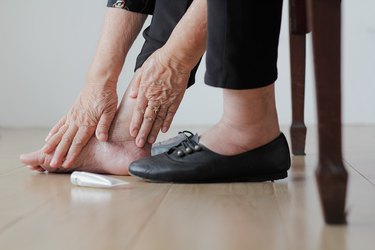
This is the fastest way to kill athlete's foot. "Typically, an over-the-counter antifungal lotion medication cream combined with proper foot care can reduce and/or eliminate the condition fairly quickly," Dr. Mendeszoon says.
How to Use It
Wash and dry your feet well. Apply antifungal lotion to affected areas — particularly around and between the toes — as directed on the package.
As for which kind of lotion to get, there are a slew of options; look for one containing the active ingredient clotrimazole, ketoconazole or nystatin. In the Biomedical and Pharmacology Journal study, athlete's foot fungus was found to be highly sensitive to these. And Dr. Mendeszoon says there's no need to shell out extra moola for the name brand; the generic antifungal cream is equally effective.
Tip
Some antifungal creams are OK for kids, while others are not. If you're treating a child's athlete foot, make sure to read the age indications on the cream's packaging before applying. And if you're unsure, check with your pediatrician or a pharmacist.
What About Undiluted Tea Tree Oil?
Dr. Mendeszoon isn't sold. Although older studies have found that applying tea tree oil to the feet can ease the symptoms of athlete's foot, the research is far from definitive.
What's more, applying undiluted essential oils directly to the skin can cause irritation.
The Stages of Athlete’s Foot
Athlete's foot doesn't appear suddenly. "Rather, it progresses slowly over a period of time," Dr. Mendeszoon says. "You might not even pick up on it at first."
Here's how it takes root:
- At first, you might notice your foot is itchy or see a bit of dry or peeling skin, especially between your toes.
- Eventually red spots or blisters might appear.
- If it spreads to your toenails, they will turn thick and cloudy.
- In cases of chronic athlete's foot, your skin will turn leathery and begin flaking and scaling.
- If you scratch the skin too much, it can cause bleeding and further spread the infection.
- In SOS situations, your feet and toenails might develop a nasty stench and pus-filled sores, which make you vulnerable to a bacterial infection.
As for signs your athlete's foot is under control and healing? You'll notice a gradual lessening of whatever symptoms you experienced.
How to Handle Stubborn Cases of Athlete's Foot
What if athlete's foot doesn't respond to treatment? Welcome to the club! It's often a chronic condition.
"It is a challenge to completely eradicate athlete's foot, and there's no guarantee that people can get rid of it forever," Dr. Mendeszoon says. "If the condition is permanent, then managing the symptoms — itching, burning, pain — becomes all the more important."
The good news is that for most people, it won't interfere with your daily life (aside from possibly making you second-guess those cute strappy sandals).
"That said, it can be aggressive — particularly in those who are immunocompromised, like if you have diabetes, cancer or a recent surgery," Dr. Mendeszoon says. "Check with your doctor if you're concerned — in some severe cases, a prescription oral antifungal medication can be taken for up to six weeks to attack the fungus internally."
- Cleveland Clinic: "4 Ways You Can Avoid Stinky Feet"
- Journal of Drugs in Dermatology: "Anti-inflammatory activities of colloidal oatmeal (Avena sativa) contribute to the effectiveness of oats in treatment of itch associated with dry, irritated skin"
- BMC Research Notes : "Co-operative inhibitory effects of hydrogen peroxide and iodine against bacterial and yeast species"
- Biomedical and Pharmacology Journal : "A Comparative Study Between Specific and Non-Specific Antifungal Agents to Treat the Rhodotorula Mucilaginosa Athletes foot"
- BMJ Clinical Evidence: "Athlete's foot: oral antifungals"
Is this an emergency? If you are experiencing serious medical symptoms, please see the National Library of Medicine’s list of signs you need emergency medical attention or call 911.